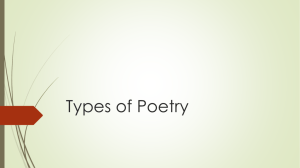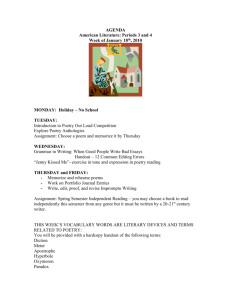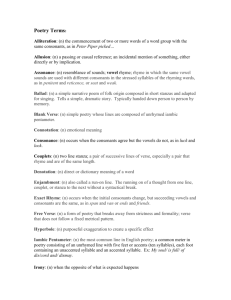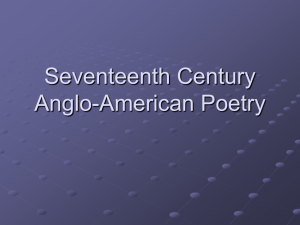A Brief History of Poetry
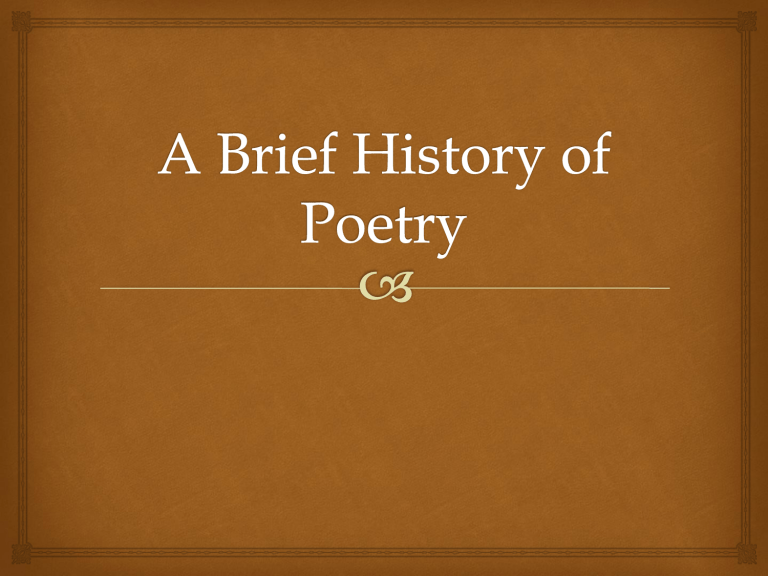
Predates literacy
Frequently employed as a means of
recording oral history,
storytelling (epic poetry),
genealogy,
law and
other forms of expression or knowledge that modern societies might expect to be handled in prose.
Examples: The Ramayana; the Norwegian sagas
Why Poetry?
Easy to remember because of its formal nature: rhythm, rhyme, refrains, etc.
Today we have the alphabet song and Grammar
Rock that help us remember cultural information in the same way
Poems were composed for, or during, performance in preliterate societies…this meant there was some fluidity of wording, things could change from performance to performance
With literacy…
The content of poems became fixed to the version that happened to be written down and survive.
Poets began to compose not for an audience that was sitting in front of them but for an absent reader.
With the invention of printing, poets were now writing more for the eye than for the ear.
Poetry and Rhythm
Different types of meter played key roles in
Classical, Early European, Eastern and Modern poetry.
Free verse broke away from the rules of meter and defined structure – English poetry was especially breaking away from iambic pentameter and blank verse (unrhymed iambic pentameter)
In the case of free verse , the rhythm of lines is often organized into looser units of cadence (the rise and fall of sounds of voice)
English Poetry & Rhythm
In English, rhythm comes from the different stress we put on accented and unaccented syllables: try it with your name:
Marie
Oliver
Lena
Poetry and Rhyme
Much modern poetry avoids traditional rhyme schemes.
Classical Greek and Latin poetry did not use rhyme.
Rhyme did not enter European poetry at all until the
High Middle Ages, when it was adopted from the
Arabic language.
Watch for internal and slant rhyme in Neruda’s poetry, as well as assonance , repeated vowel sounds within the line
Alliteration and Parallelism
Germanic and Old English poetry used patterns of alliteration
Alliteration and rhyme help to emphasize and define a rhythmic pattern
Biblical poetry in ancient Hebrew used parallelism , where successive lines reflected each other in grammatical structure, sound structure, notional content, or all three
This lent itself to call- and-response performance.
Free Verse and Sound
Sound plays a more subtle role in free verse poetry
Free verse poets use it to create pleasing, varied patterns and emphasize or sometimes even illustrate semantic elements of the poem.
Devices such as alliteration , assonance , consonance , dissonance and internal rhyme are among the ways free verse poets use sound.
Euphony refers to the musical, flowing quality of words arranged in an aesthetically pleasing way.
Poetry and Form
Compared with prose, poetry depends less on the linguistic units of sentences and paragraphs, and more on units of organization that are purely poetic.
Typical structural elements: the line , couplet , and stanza
Lines may be end-stopped (ends in a period) or enjambed (runs on to the next line)
Poets use enjambment to create a sense of expectation in the reader and/or to add a dynamic to the movement of the verse.
Line Length
In English poetry, the most traditional line length is
10 stressed syllables (iambic pentameter)
Mary Oliver argues that lines longer than 10 syllables (like Walt Whitman’s) communicate expanse, and super-human capacity
Oliver says that lines shorter than 10 syllables communicate intensity and a smaller than human focus/idea
How it looks on the page
With the advent of printing, poets gained greater control over the visual presentation of their work.
The use of lines, couplets, stanzas, and of the white space they help create, became an important part of the poet's toolbox.
Modernist poetry tends to take this to an extreme, with the placement of individual lines or groups of lines on the page forming an integral part of the poem's composition.
